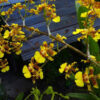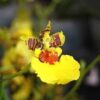# The Impact of Climate Change on the Development of Dancing Lady Orchids (*Oncidium*)

Climate change represents one of the most significant challenges facing global biodiversity and ecosystems today. Among the myriad species affected by changing environmental conditions are the orchids, particularly the popular and stunning Dancing Lady Orchids (*Oncidium*). These exquisite flowers, known for their unique shapes and vibrant colors, thrive in various habitats across the tropical and subtropical regions of the world. However, as climate change alters temperature, precipitation patterns, and humidity levels, the growth and survival of these orchids are increasingly at risk. This article explores the impacts of climate change on the development of Dancing Lady Orchids, examining various aspects such as habitat loss, physiological changes, and conservation strategies.
## Table of Contents
1. [Introduction to Dancing Lady Orchids](#introduction-to-dancing-lady-orchids)
2. [Understanding Climate Change](#understanding-climate-change)
3. [Effects of Climate Change on Orchid Habitat](#effects-of-climate-change-on-orchid-habitat)
– 3.1 [Temperature Changes](#temperature-changes)
– 3.2 [Altered Rainfall Patterns](#altered-rainfall-patterns)
– 3.3 [Humidity Variations](#humidity-variations)
4. [Physiological Responses of Dancing Lady Orchids](#physiological-responses-of-dancing-lady-orchids)
– 4.1 [Photosynthesis and Growth](#photosynthesis-and-growth)
– 4.2 [Reproductive Success](#reproductive-success)
– 4.3 [Disease and Pest Vulnerability](#disease-and-pest-vulnerability)
5. [Impacts on Orchid Cultivation and Trade](#impacts-on-orchid-cultivation-and-trade)
6. [Conservation Strategies and Solutions](#conservation-strategies-and-solutions)
7. [Conclusion](#conclusion)
—
## 1. Introduction to Dancing Lady Orchids
Dancing Lady Orchids, belonging to the genus *Oncidium*, are native to the Americas, particularly in Central and South America. Renowned for their striking flower shapes that resemble dancers in motion, these orchids have captured the hearts of horticulturists and flower enthusiasts around the globe. They are primarily epiphytic, growing on trees and requiring specific environmental conditions for optimal growth. With their colorful blooms and captivating fragrances, *Oncidium* orchids have become staples in floral arrangements and horticultural collections.
Despite their beauty and popularity, the future of Dancing Lady Orchids is uncertain due to the escalating impacts of climate change. As global temperatures rise and weather patterns shift, the ecosystems that support these orchids face unprecedented challenges.
## 2. Understanding Climate Change
Climate change refers to long-term alterations in temperature, precipitation, wind patterns, and other elements of the Earth’s climate system. The primary driver of contemporary climate change is human activity, particularly the burning of fossil fuels, deforestation, and industrial processes, leading to increased greenhouse gas concentrations in the atmosphere.
The effects of climate change are widespread and include:
– Rising global temperatures
– Increased frequency and intensity of extreme weather events
– Changes in rainfall patterns and distribution
– Sea level rise
– Altered ecosystems and biodiversity loss
These changes have profound implications for various species, particularly those that are sensitive to environmental conditions, such as orchids.
## 3. Effects of Climate Change on Orchid Habitat
The habitats of Dancing Lady Orchids are crucial for their growth and development. Climate change poses several threats to these environments, impacting the survival of *Oncidium* orchids in various ways.
### 3.1 Temperature Changes
Temperature is a critical factor influencing orchid growth and flowering.
– **Optimal Growth Conditions**: *Oncidium* orchids thrive in warm, humid environments. Most species prefer temperatures ranging from 20°C to 30°C (68°F to 86°F). As global temperatures rise, orchids may experience heat stress, leading to reduced growth rates and poor flowering.
– **Phenological Shifts**: Changes in temperature can cause shifts in the timing of growth and flowering. For instance, earlier springs and warmer winters may disrupt the synchronized relationship between orchids and their pollinators, affecting reproductive success.
– **Geographical Range Shifts**: As temperatures increase, orchids may be forced to migrate to higher altitudes or latitudes in search of suitable climates. However, suitable habitats may become limited due to geographical barriers or habitat destruction.
### 3.2 Altered Rainfall Patterns
Changes in precipitation patterns can significantly impact the availability of water resources essential for orchid growth.
– **Increased Drought Conditions**: Some regions may experience reduced rainfall, leading to drought conditions. Orchids rely on consistent moisture levels, and prolonged dry periods can lead to dehydration and stress, inhibiting growth and flowering.
– **Intense Rainfall Events**: Conversely, areas experiencing increased rainfall may face flooding and waterlogging, which can suffocate orchid roots and lead to root rot. The balance of moisture is crucial for the health of these delicate plants.
### 3.3 Humidity Variations
Humidity is another vital factor in the growth of Dancing Lady Orchids.
– **Optimal Humidity Levels**: Most *Oncidium* orchids prefer humidity levels between 50% and 70%. Changes in humidity due to climate fluctuations can affect their physiological processes, including transpiration and nutrient uptake.
– **Stress and Adaptation**: In environments where humidity levels drop, orchids may struggle to adapt, leading to stress and potential decline. Increased humidity, on the other hand, can promote fungal infections and other diseases.
## 4. Physiological Responses of Dancing Lady Orchids
The physiological responses of *Oncidium* orchids to climate change are multifaceted and can influence their growth, reproduction, and overall health.
### 4.1 Photosynthesis and Growth
Photosynthesis is fundamental to plant growth, and any disruptions in this process can have cascading effects.
– **Impact of Temperature on Photosynthesis**: Rising temperatures can affect the efficiency of photosynthesis in orchids. Heat stress can denature enzymes involved in photosynthesis, leading to decreased carbon fixation and stunted growth.
– **Nutrient Uptake**: Climate change can also influence the availability of nutrients in the soil. Higher temperatures may increase nutrient leaching, while changes in moisture levels can affect nutrient absorption by the roots.
### 4.2 Reproductive Success
The ability of Dancing Lady Orchids to reproduce successfully is crucial for their survival in changing environments.
– **Pollinator Relationships**: Many *Oncidium* species rely on specific pollinators for reproduction. Changes in climate may alter the distribution and behavior of these pollinators, impacting the orchids’ ability to reproduce.
– **Seed Viability**: Environmental stresses caused by climate change can affect seed viability and germination rates. Conditions that are too hot or too dry may result in lower seed production and fewer successful germinations.
### 4.3 Disease and Pest Vulnerability
Climate change can increase the vulnerability of *Oncidium* orchids to diseases and pests.
– **Fungal Infections**: Increased humidity and temperature create favorable conditions for fungal pathogens, leading to diseases such as root rot and leaf spot. These diseases can devastate orchid populations and affect commercial cultivation.
– **Pest Outbreaks**: Warmer temperatures may enable pest populations to thrive, leading to increased infestations. Common pests, such as aphids and mealybugs, can damage orchids, compromising their health and growth.
## 5. Impacts on Orchid Cultivation and Trade
The effects of climate change extend beyond wild populations of *Oncidium* orchids to commercial cultivation and trade.
– **Reduced Crop Yields**: Growers may experience decreased yields due to the adverse effects of climate change on orchid health. This can lead to financial losses for commercial orchid farms.
– **Changing Market Demand**: As certain species become rarer due to climate impacts, the demand for specific orchids may increase. This can lead to overexploitation of wild populations, further threatening their survival.
– **Adaptation Strategies**: To mitigate the impacts of climate change, orchid growers may need to adapt their cultivation practices. This could include implementing greenhouse technologies to regulate temperature and humidity or selecting more resilient orchid varieties.
## 6. Conservation Strategies and Solutions
Conserving Dancing Lady Orchids in the face of climate change requires a multifaceted approach that includes habitat preservation, sustainable practices, and public education.
– **Habitat Protection**: Protecting the natural habitats where *Oncidium* orchids thrive is crucial for their survival. Conservation organizations and governments can work together to establish protected areas and enforce environmental regulations.
– **Sustainable Cultivation Practices**: Encouraging sustainable cultivation practices among growers can help mitigate the impacts of climate change. This includes using organic methods, maintaining biodiversity, and minimizing chemical inputs.
– **Public Awareness and Education**: Raising awareness about the threats posed by climate change to orchids can foster support for conservation efforts. Educational programs can inform the public about the importance of preserving biodiversity and the beauty of orchids.
– **Research and Monitoring**: Ongoing research into the effects of climate change on orchids is essential. Monitoring populations and studying their responses to changing conditions can inform conservation strategies and help identify at-risk species.
## 7. Conclusion
The impact of climate change on the development of Dancing Lady Orchids (*Oncidium*) is profound and multifaceted. As temperatures rise, rainfall patterns change, and humidity levels fluctuate, these beautiful orchids face significant challenges that threaten their growth, reproduction, and survival.
Understanding these impacts is crucial for developing effective conservation strategies and fostering resilience among orchid populations. By prioritizing habitat protection, promoting sustainable cultivation practices, and raising public awareness, we can work towards preserving the delicate balance that sustains Dancing Lady Orchids and the ecosystems they inhabit. As we move forward in an era of climate change, our collective efforts will determine the fate of these stunning flowers
and the natural heritage they represent.

